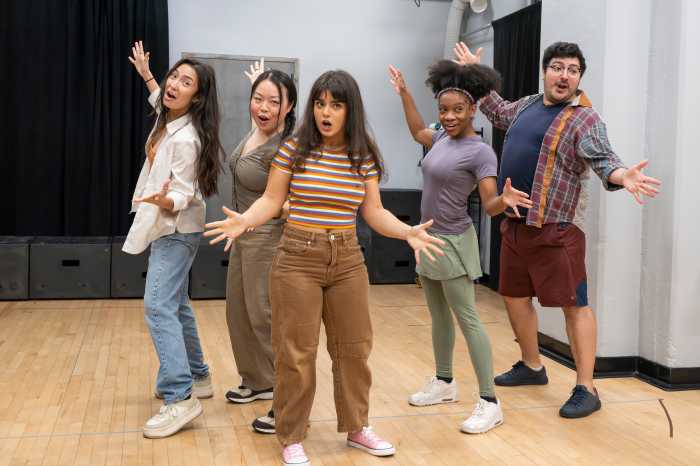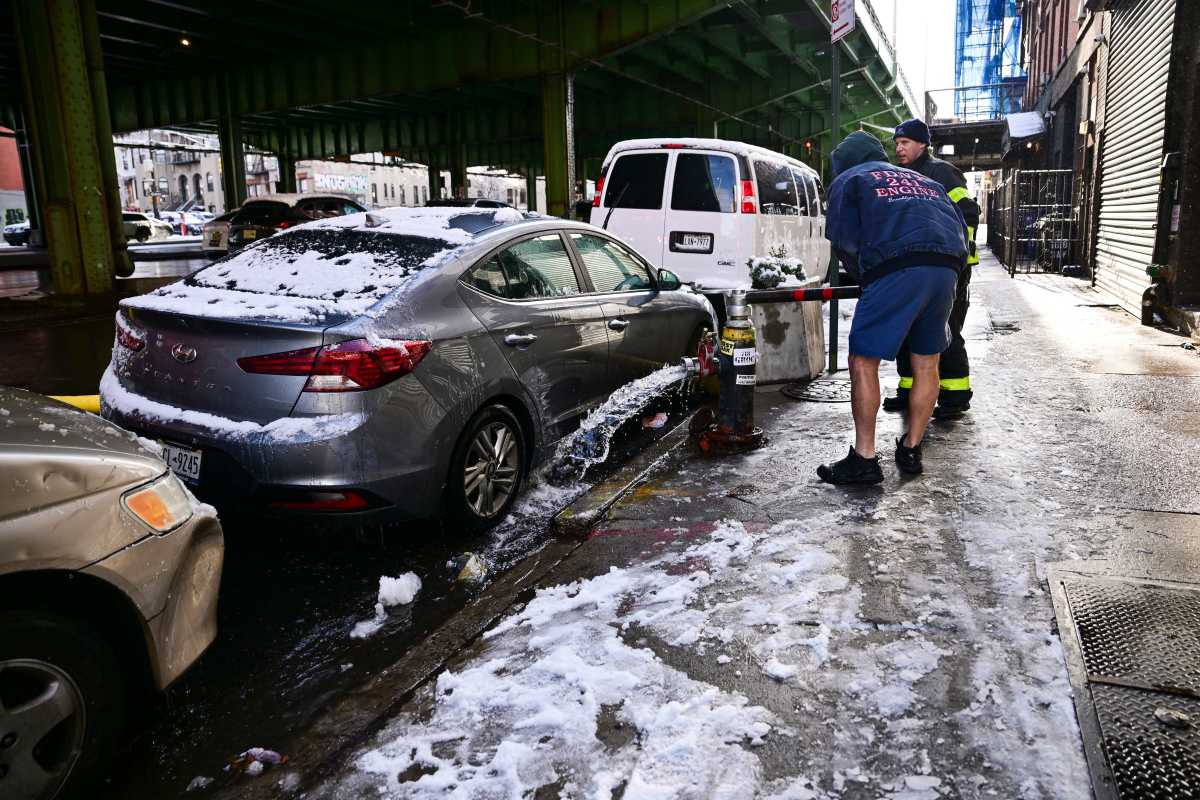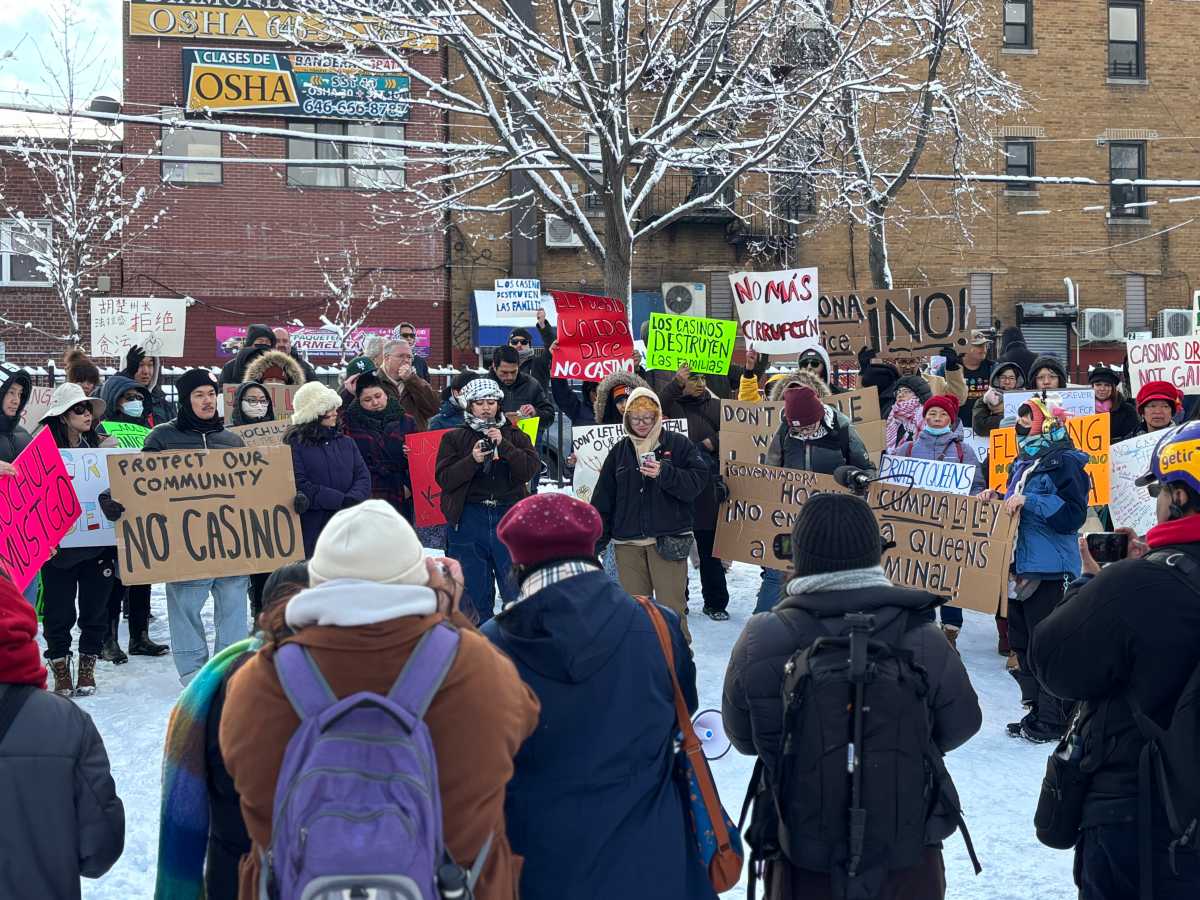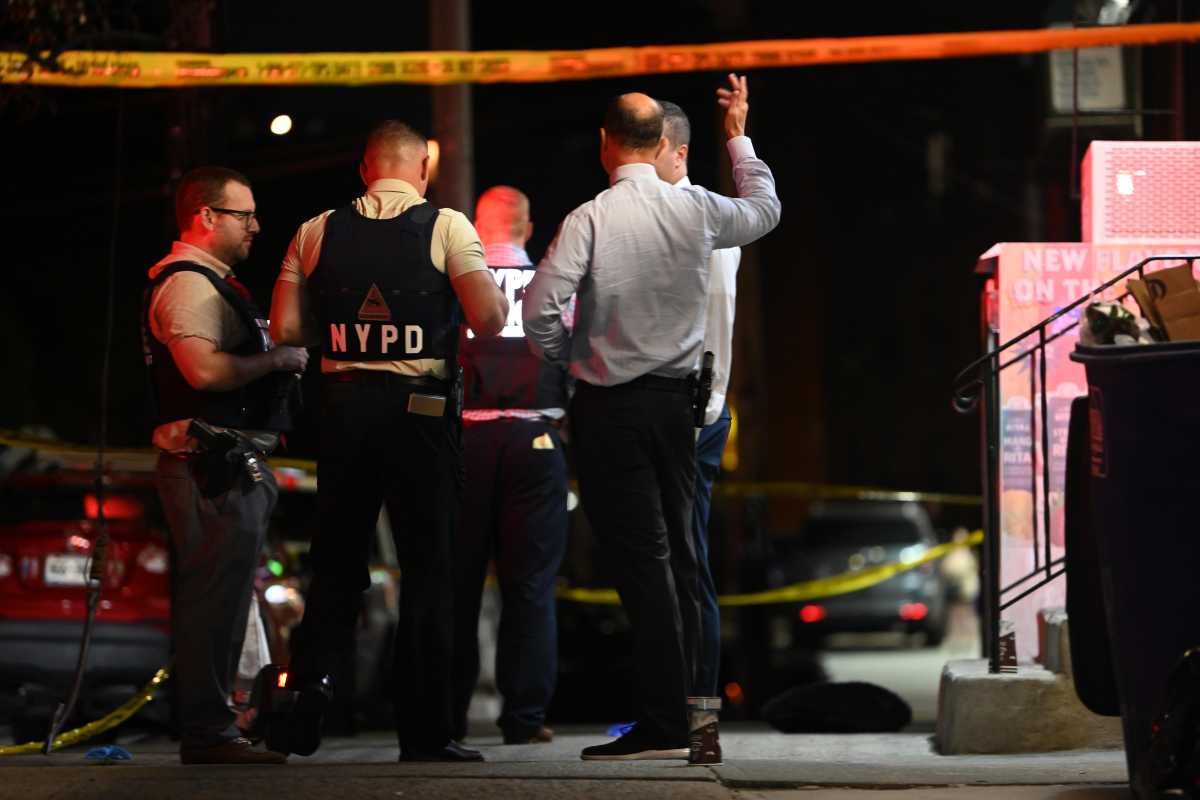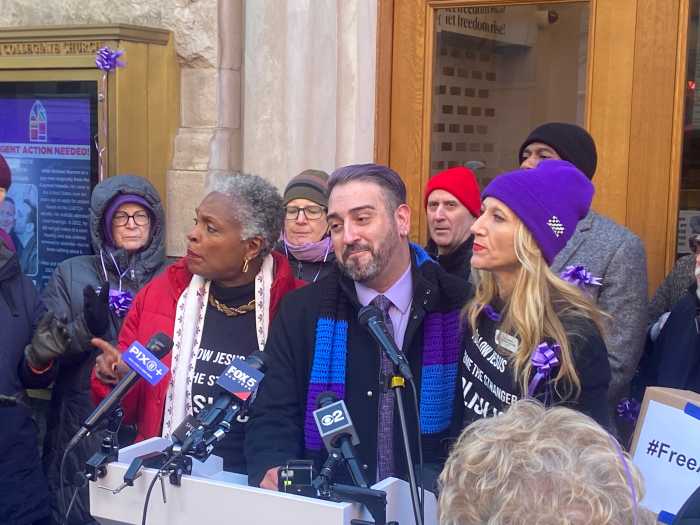By Lawrence Lerner
Bobby Slayton calls himself the pit bull of comedy. Judging from his stand-up set at Chelsea’s Gotham Comedy Club two weekends ago, that title is apropos.
With his brazen, take-no-prisoners style, Slayton derided gays, blacks, whites, Asians, Catholics and Jews (of which he is one) during his hourlong performance, leaving the crowd alternating between nervous laughter and bellyaching guffaws.
His animated act, full of wild gesticulations and piercing declarations, also drew a smattering of remarks from the audience, including protests from an Asian-American woman in the front row who walked out 30 minutes into the performance after Slayton refused to let up.
“When I get heckled, it’s usually about my material,” said Slayton between sets at Gotham on a recent Saturday night. “Much of my act is about putting other people down. You know, it’s one way of helping me feel better about myself.”
Slayton, who is considered a stand-up master after 25 years at the mic, works with unrivaled intensity, routinely walking a fine line between humor and comic dissonance that has audiences gasping. But if anything can be said about the tension he produced in the room that evening, it is this seminal fact: that night after night, comics are always only a line away from being heckled.
Michael Richards, the 57-year-old ex-star of the hit television show “Seinfeld,” discovered as much in mid-November when two black audience members traded barbs with him at the Laugh Factory in West Hollywood, Cal., sending him into a racist tirade heard round the world. But for seasoned comedians working the club circuit for a living, dealing with heckling is just part of the job.
“I’ve been heckled a million times,” said comedian Brad Trackman, who hosted the Slayton-headlined show. “And when you first start out, it is one of the scariest experiences a comedian has to face. But you inevitably will, so you’d better learn how to deal with it.”
An unwieldy form of audience participation to be sure, heckling emerges for many reasons. In Slayton’s case, it is usually his offensive material. But in far too many instances, it is intoxication on the part of patrons. In Richards’s situation, it was an act that bombed, along with poor crowd control.
“Michael is a great comedic improv actor and not a seasoned stand-up comic,” said Slayton. “I’ve heard it’s happened to him before, where he just snapped onstage. Evidently, he ripped into some college kid a few weeks before. It wasn’t a racial thing, but he’s bit of a loose canon. A real stand-up comedian would have handled these situations differently.”
That Richards was playing with the big boys in big venues didn’t help matters any, according to Trackman.
“Look, he’s learning the ropes in big clubs, going onstage preceded and followed by seasoned comics who are night-and-day better than he is,” Trackman said. “He’s getting these spots because of his fame, but that luxury is a double-edged sword. Like Jerry [Seinfeld] said, ‘Audiences will give me the first 10 minutes because I’m Jerry Seinfeld, but after that, they’re thinking, Make me laugh.’”
All of that left the comedian otherwise known as Kramer even more vulnerable to heckling than he might have been had he worked the small-club circuit first, according to Slayton, who emphasized that the hecklers at the Laugh Factory put an arrow through Richards’s heart by implying: You’re not funny.
“I can’t say I like that either, but when people yell that kind of stuff at me, it doesn’t bother me because, for the most part, people are laughing,” said Slayton. “I guess when Michael was on, no one was laughing. So, when someone says you’re not funny, that just puts salt in the wound. And he just snapped.”
Club security, or the lack thereof, also played a role in Richards’s implosion, according to Gotham Comedy Club owner Chris Mazzilli, a former stand-up comic who has been in the business for 20 years. Mazzilli was shocked that the heckling went on as long as it did in the Richards incident.
“I’m not saying that Michael was in the right using the n-word the way he did. Obviously, that was awful,” he said. “But why didn’t anyone at the club tell the guys to be quiet? I heard that Michael yelled to security to get the guys out. I can tell you this much: If a comic said that while working at Gotham, you can bet we’d get the guys out in two seconds and deal with them outside.”
It’s that level of security, among other things, that differentiates A-list comedy venues like Gotham from lesser clubs, according to several of the comics interviewed for this article. The better the security, the more comfortable they are onstage.
“That’s a hugely important issue,” said Trackman. “Some venues, believe it or not, have no security at all.”
But while a lack of security can send a message to patrons that it is open season on comics, many comedians see that as inherent in the business anyway. Comparing stand-up comedy performances to Broadway shows or music concerts, they lament that their chosen profession — in the words of the immortal Rodney Dangerfield — gets no respect.
“People should not be allowed to heckle at comedy shows. It’s an art form up there, and it’s not as esteemed as it should be,” said Kevin Flynn, a 15-year stand-up veteran who was in the audience at the Saturday evening show. “If you don’t like a jazz performance, you’re not going to yell s–t. But with comics, people feel that if they don’t like you, they can just shout you down.”
While Flynn acknowledges that a certain level of interaction makes live stand-up special, he believes the give-and-take between comedian and audience should be driven primarily by the comedian.
“If a comic asks you a question, you answer it and go with the flow, but that’s the extent of it,” he said. “After all, people come to see comedians, not some drunk guy in midlevel management at some electronics firm who is on a Christmas binge and wants to impress his secretary.”
And what of patrons who are unhappy with the show?
“People have a vote here,” said Flynn. “If you don’t like my act, get up and leave. Don’t come and see me again. And I’ll be out of the business if more people do that. But don’t yell and distract and ruin the show for me and the rest of the audience.”
Trackman backs Flynn’s position, with one caveat: He says it is important to distinguish between “those who heckle to be part of the show, sometimes positively, and those who are coming at you.”
While that may be true, most comics nevertheless find benign hecklers annoying at best and disruptive at worst. Mazzilli recalls that when he pacified problem patrons during his long tenure at the mic, he was often greeted with the most unlikely of excuses after the show.
“I would often go rapid fire on disruptive guys to where they’d bow their head down and wave a white flag — you know, using a napkin,” said Mazzilli. “And then afterward, a lot of time the guy will come up to me and say, ‘Hey man, you know, I was just trying to help out.’ My feeling is, ‘Well, don’t help out.’ And the thing is, I guarantee that if you talk to other comics, you’ll hear the same thing. I’ve heard that a million times.”
Whatever the reason for heckling or the nature of the hecklers themselves, seasoned comics have an arsenal of tools at their disposal for handling such situations, honed over years of coming face to face with adversity. And though each comedian deploys his or her own style when battling deep in the trenches, the similarities in their approaches outweigh the differences.
“The general idea is to put the guy down and shut him up while everybody else is laughing. It’s not a tangible thing. There’s no one way to do it,” said Slayton. “The standard way is to use stupid heckler lines like, ‘Listen buddy, when you’re working, I don’t come to Burger King and kick the broom out of your hands.’ But you tend to rely on those when you’re a young comic just starting out. I rarely use them anymore.”
Slayton’s dictum is valuable fodder for would-be comics everywhere: While isolating the heckler is important, it means little unless you keep the audience on your side.
“You have to get the audience in your pocket. Absolutely,” agreed Mazilli.
But according to Flynn, getting the audience there in the first place takes time.
“If someone heckles you when you first come on, or a minute or two into your act, it’s difficult to go at them because you’re still trying to sell the audience on you, get out there with a few jokes and get them to like you so you’re their boy,” he said. “Once the crowd’s with you, then when someone says something offensive, you can turn it on them.”
Mazzilli, who handled hecklers tactfully if somewhat aggressively in his day, takes this one step further, saying that generating empathy in the heat of the moment is also important. In fact, he says it is the best setup for subduing rogue audience members.
“If people start to heckle me, I say, ‘Look, I’m here to have a good time, and these people want to have a great time, too. So, please don’t disrupt the show.’ In effect, you’re saying, ‘Hey, I don’t want to go down that path. I’m a nice guy. We’re all in this together,’ ” said Mazzilli.
“Then I can add: ‘But I do this for a living. So, if you continue messing with me, I’m going to bury you and embarrass you in front of your friends. So, if that’s the route you want to go, it’s fine, and I’m fully prepared to do that, but I’d rather do my material. So, the choice is up to you,’” he said.
For Mazzilli, burying a heckler usually meant following Slayton’s lead and putting their flaws under a microscope.
“If you look at any person, you can find something to go at. If the guy’s fat, you say, ‘So, how’d you get into this place anyway: Did they open up a garage door?’ If he’s bald, you go, ‘Hey, I guess the rumors are true: If you play with yourself, you lose your hair,’ or ‘Hey Kojak, why don’t you shut the f–k up,’ ” said Mazzilli.
“Or you can knock a guy’s job. Most people don’t have exciting jobs,” he continued. “I remember I had one guy giving me a hard time, and I went, ‘So, what do you do for a living?’ Turns out he was a waiter. So, I said, ‘O.K., then. So, shut up and go get me a drink.’ He laughed. The audience laughed. And it was over quickly.”
There is another caveat here, however: Regardless of the approach used by comics to put hecklers in their place, it is imperative that they conceal their anger well, says Trackman, who insists it is better to “use honey if you want to attract bees.”
“No matter how bad the person is, you can never show the audience you’re angry, even if it’s not your fault and you’re justified in getting angry at the guy — because now the audience is no longer looking at you as a comedian but instead as a person, a person who’s pissed,” he said.
“I mean, just take Michael Richards as a case in point,” Trackman added. “He was really embarrassed that he wasn’t doing well, and he just wore his anger on his sleeve and lost the audience, directing his anger at a particular group on top of that. What a mess.”















